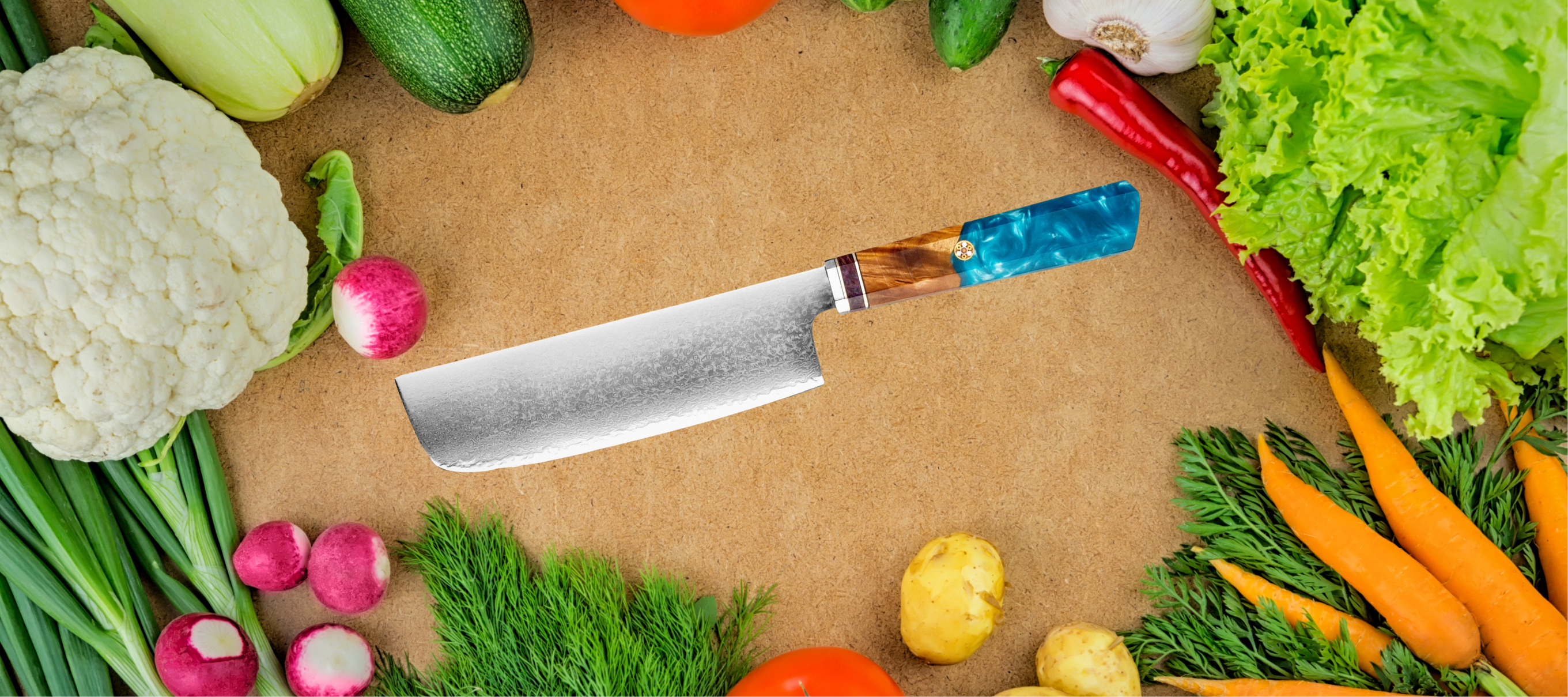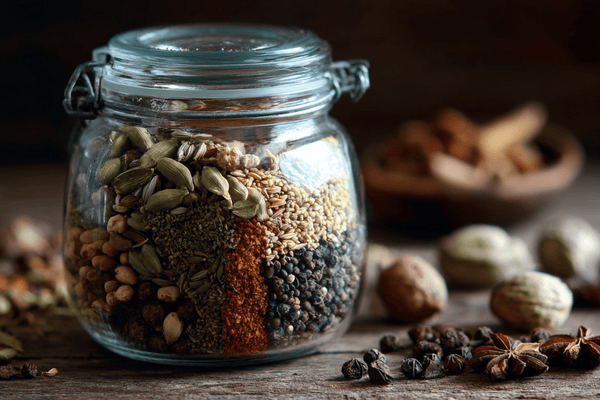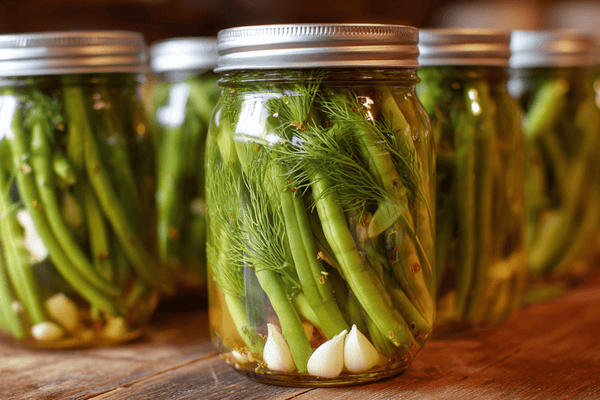 Whether you’re a strict vegetarian or someone who loves some fresh veggies alongside a meat dish, we all need a good knife for cutting vegetables. Japanese knives are prized for their sharp blade and ability to cut precisely. However, there are a lot of different types of knives and this can make it confusing to choose the best Japanese knife for chopping vegetables.
Whether you’re a strict vegetarian or someone who loves some fresh veggies alongside a meat dish, we all need a good knife for cutting vegetables. Japanese knives are prized for their sharp blade and ability to cut precisely. However, there are a lot of different types of knives and this can make it confusing to choose the best Japanese knife for chopping vegetables.In truth, several Japanese knives excel when it comes to cutting veggies. The usubu, nakiri and santoku knives are among the very best, although many argue that the usubu is the original Japanese vegetable knife.
If you’ve been struggling to choose the right Japanese knife for cutting veggies, you’ll find all the information you need in this guide.
Table of contents
The Best Japanese Vegetable Knives
Japan is renowned for its high-quality knives so it will come as no surprise that there are several different types to choose from when it comes to cutting vegetables. Let’s take a look at some of the most popular Japanese vegetable knives.
Usuba
The usuba is a Japanese knife that is traditionally designed with vegetables in mind. All Japanese chefs have an usuba knife in their arsenal and the word usuba means thin blade. This thin-bladed knife has a curved cutting edge. It is extremely sharp and therefore doesn’t rip, tear or otherwise break down the vegetables which could affect their quality.
The usuba finds its origins in Kanto, a region of Tokyo and is largely used by professional chefs. While it can be used by domestic chefs, it’s important to keep in mind that there is a certain amount of skill required to use the usuba knife.
What’s great about these knives is that they are designed to cut very thin slices but this is where that skill we mentioned comes in. Typically, an usuba knife would be sharpened for right-handed use but there are left-handed versions out there.
Santoku
 The santoku is a versatile, multi-purpose Japanese knife that is ideal for cutting vegetables. That said, it is often called the three-virtues knife as it’s suitable for not just veggies but also meat and fish. This knife is incredibly common in both professional kitchens and for home use.
The santoku is a versatile, multi-purpose Japanese knife that is ideal for cutting vegetables. That said, it is often called the three-virtues knife as it’s suitable for not just veggies but also meat and fish. This knife is incredibly common in both professional kitchens and for home use.While other multi-purpose Japanese knives will do well with vegetables, the santoku is a cut above the rest. It’s great for dicing, slicing and mincing for all types of vegetables. However, since these are relatively flexible blades, you may find that veggies with thicker skin, such as butternut squash, aren’t as easy to cut with a santoku.
What many people enjoy about using a santoku knife is that they are incredibly lightweight and agile. If you want a knife that’s extremely comfortable and easy to use then this is a great choice; this also makes it perfect for beginners.
Nakiri
 The word nakiri actually translates to mean leaf cutter so it goes without saying that this is one of the best Japanese knives for vegetables. The nakiri vegetable knife is a traditional type of Japanese blade with a single bevel, rectangular shape with a flat cutting edge and so it easy to tell apart from many other types of Japanese blade.
The word nakiri actually translates to mean leaf cutter so it goes without saying that this is one of the best Japanese knives for vegetables. The nakiri vegetable knife is a traditional type of Japanese blade with a single bevel, rectangular shape with a flat cutting edge and so it easy to tell apart from many other types of Japanese blade.What’s great about the nakiri is that it will stand up to more heavy-duty challenges that something like a santoku wouldn’t be as adept at. The shape of the blade means that you can cut through the food, right to the cutting board, without having to force anything.
The nakiri has a thin blade and a lot of knuckle clearance which makes it a favourite for chopping, especially when repetition is needed. Traditional Japanese chefs would use this type of knife for fast, efficient chops as well as for tasks like slicing and mincing.
Another reason that this type of knife is so good for cutting vegetables is the balance. Since the balance is slightly closer to the tip, you are able to achieve a much more precise cut with this nimble knife.
However, if you’re looking for a Japanese knife that will allow you to use the rocking motion technique, the nakiri isn’t going to be the right choice. This is because of the flat, straight edge that isn’t designed for this type of cutting. Moreover, since the nakiri blade is quite thin, it isn’t suitable for things like meat and fish. For this, you would need something like a gyuto knife.
That said, they’re incredibly versatile and can be used for everything from heavy-duty cutting to finely chopping leaves and it really is one of the best knives for vegetables.
Some Additional Japanese Knives You Can Use for Vegetables
The knives we have already discussed are among some of the best Japanese vegetable knives. However, there are some other types of Japanese knives that you can use for vegetables. These are typically more multi-purpose knives, so if you’re pushed for space in the kitchen and want to buy a versatile blade, then the following two might be just what you’re looking for.
Gyuto
 The gyuto is perhaps one of the most famous types of Japanese kitchen knives. This sharp knife is similar to the santoku in many ways; we have a guide on the differences if you’re keen to learn more. The main reason that these two knives are considered similar is their versatile use although the gyuto has a few more uses making it slightly more multi-purpose.
The gyuto is perhaps one of the most famous types of Japanese kitchen knives. This sharp knife is similar to the santoku in many ways; we have a guide on the differences if you’re keen to learn more. The main reason that these two knives are considered similar is their versatile use although the gyuto has a few more uses making it slightly more multi-purpose.In any case, the gyuto is a brilliant choice for cutting vegetables, especially where you need to dice and chop. What’s more, the curved blade means that using the rocking motion technique is a breeze.
The gyuto was inspired by the western chef’s knife but the beauty of this Japanese version is that it is far more lightweight and less bulky. You get the benefit of the multipurpose design of the German knife but with the lightweight design of the santoku.
One of the things that makes the gyuto such a popular choice is that it’s a lot easier to handle than many other Japanese knives. You see, pretty much all Japanese knives are single bevel which requires a bit of a learning curve. But the gyuto is a double bevel blade so it’s much easier to handle, even if you’ve never used one before.
Petty
 The petty knife is a type of Japanese paring knife. Note that the blade is far shorter than the gyuto that we have just discussed but it’s just as versatile in its own way.
The petty knife is a type of Japanese paring knife. Note that the blade is far shorter than the gyuto that we have just discussed but it’s just as versatile in its own way.When it comes to cutting vegetables, the petty knife is exceptional and does come in a range of shapes and sizes so you can choose something that matches your needs.
That said, most Japanese petty knives come with a straight edge and an incredibly sharp tip which is brilliant as a sharp-tipped paring knife and is equally suited to slicing. But they are considered a multi-purpose knife.
There are also some petty knives that feature a shape similar to a bird’s beak which makes them perfect for working with fruits, especially citruses.
You might also find a sheepsfoot petty knife which is flatter and slightly longer than regular petty knives. These are brilliant when a recipe calls for paring or slicing smaller vegetables such as garlic or shallots.
What to Think About When Choosing a Japanese Vegetable Knife
When it comes to choosing the right Japanese vegetable knife, it’s evident that you’re not short on options. However, which you go for will depend on several factors and it’s worth thinking carefully before selecting your knife.One of the first things you will need to think about is what you’re planning to cut. For example, if you’re looking to chop thick, dense vegetables then there’s no point choosing a santoku when a nakiri knife would easily be the better option.
You should also think about the features of the knife such as its size and how sharp it is. It goes without saying that, for smaller foods, a smaller blade will be easier to work with as you’ll get precision. For bigger food items, you’ll need a larger blade that will cut all the way through without stopping. When cutting larger items, you should also look for a knife whose blade is slightly wider otherwise you may find that it gets stuck halfway through.
The last thing you’ll want to consider is the material from which the blade is made. You’ll find that pretty much all Japanese knives are made from something like high-carbon steel, forged steel and other types of hard steel. This means that the blade benefits from better edge retention, not to mention it’ll be sharper from the get-go.


